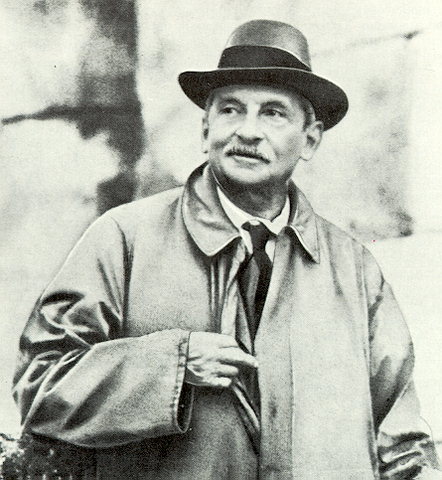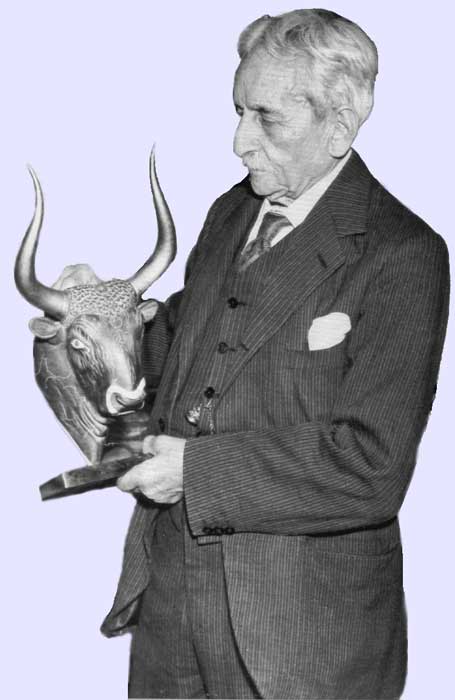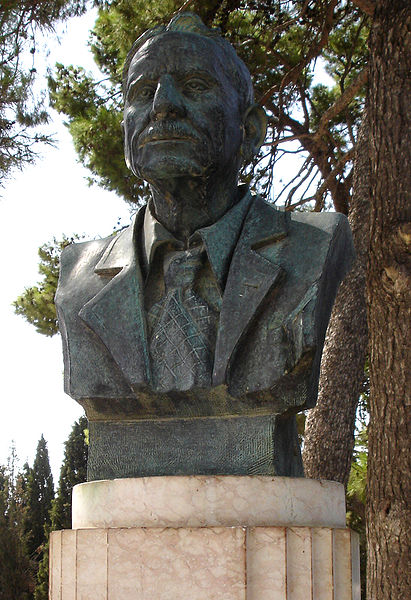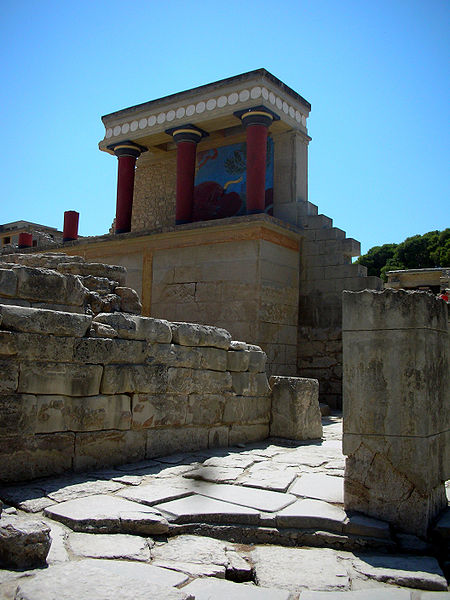<Back to Index>
- Archaeologist Sir Arthur John Evans, 1851
- Painter Artemisia Gentileschi, 1593
- Chief Minister of West Bengal Jyoti Basu, 1914


Sir Arthur John Evans (8 July 1851 – 11 July 1941) was a British archaeologist most famous for unearthing the palace of Knossos on the Greek island of Crete and for developing the concept of Minoan civilization from the structures and artifacts found there and elsewhere throughout eastern Mediterranean. Evans was the first to define Cretan scripts Linear A and Linear B, as well as an earlier pictographic writing.
Along with Heinrich Schliemann, Evans was a pioneer in the study of Aegean civilization in the Bronze Age.
The two men knew of each other and Evans visited Schliemann's sites.
Schliemann had planned to excavate at Knossos, but died before
fulfilling that dream. Evans bought the site and stepped in to take
charge of the project that was then still in its infancy. He continued
Schliemann's concept of Mycenaean civilization but soon found that he needed to distinguish it from his own concept - the Minoan. Arthur Evans was born in Nash Mills, England, the first child of John Evans and
Harriet Ann Dickinson. John Evans came from a family of men who were
both educated and intellectually active; his father, Arthur's
grandfather, had been headmaster of Market Bosworth Grammar School. John knew Latin and could quote the classical authors. In 1840, instead of going to college, he started work at a paper mill owned by his maternal uncle John Dickinson. He married his cousin and employer's daughter, Harriet, and in 1851 was made a full partner in the family business. Profits
from the mill would eventually help fund Arthur's excavations and
restorations at Knossos and resulting publications. John maintained his
status as a chief officer in the company, which eventually became John Dickinson Stationery, but also distinguished himself as an antiquary and numismatist, and as a geologist and archaeologist, publishing works on these topics. He was a member and officer of many learned societies, including being a Fellow of the Royal Society. He won the Lyell Medal and in 1892 was knighted by Queen Victoria. Unfortunately, Arthur's mother, Harriet, died in 1858 when Arthur was seven. He did have two brothers, Norman and Lewis,
and two sisters, and would remain on excellent terms with all of them
all of his life. He was raised by a stepmother, Fanny, with whom he
also got along very well. She had no children of her own and also
predeceased her husband. John's third wife was a classical scholar, and
when he was 70 they had a daughter, Joan,
who would become an art historian. By the time of John's death in 1908
at 85, when Arthur was 57, the major work on Knossos had already been
done. He had primarily used other funding for his work, but Arthur had
enjoyed the close support and assistance of his father, who contributed
significantly. Arthur was given every advantage of education. After a childhood stay at Callipers Preparatory School (no longer extant) he attended Harrow School, becoming co-editor of The Harrovian in his final year, 1869/70. At Harrow he was friends especially with Francis Maitland Balfour. After graduating from Harrow, Evans became part of and relied on the Old Harrovian network of acquaintances. Minchin characterized him as "a philologer and wit" as well as an expert on "the eastern question", i.e. diplomatic and political problems posed by the decay of the Ottoman Empire.
Arthur also continued his father's habit of quoting the appropriate
Latin author from memory and knew poems entirely by heart, as was
typical for men of his time. Between 1870 and 1874 Arthur matriculated at Brasenose College, Oxford. His housemaster at
Harrow, F. Rendall, had eased the way to his acceptance with the
recommendation that he was "a boy of powerful original mind." At
Brasenose he read modern history, but his summertime activities with
his brothers and friends were perhaps more definitive to his subsequent
career. In 1871 he and Lewis visited Hallstatt and the Balkans; in 1872 he and Norman adventured in the Carpathians, crossing borders illegally at high altitudes, pistols at the ready. In 1873 he and Balfour tramped over Lapland, Finland, and Sweden. Everywhere he went he took copious anthropological notes and made numerous drawings of the people, places and artifacts. During the Christmas holidays of 1873, Evans cataloged a coin collection being bequeathed to Harrow by John Gardner Wilkinson, the father of British Egyptology,
who was too ill to work on it himself. The headmaster had suggested "my
old pupil, Arthur John Evans - a remarkably able young man." In April-July 1875, after failing to obtain a fellowship at Oxford, Arthur attended a summer term at the University of Göttingen.
He decided not to stay and left there to meet Lewis for another trip to
the Balkans. That decision marked the end of his formal education.
However, at that time, the lack of a formal education did not preclude
one from being a successful scientist. After resolving to leave Göttingen, Arthur and Lewis planned an adventure in Bosnia-Herzegovina starting immediately in August 1875. They knew that the region, a part of the Ottoman Empire, was under martial law, and that the Christians (mainly the Serbs) were in a state of insurrection against the Bosnian Muslim beys placed
over them. Ottoman troops were in the country in support of the beys.
The two brothers had no problem with either the Serbs or the Ottomans
but they did provoke the neighboring Austro-Hungarian Empire, and spent the night in "a wretched cell." After deciding to lodge in a good hotel in Slavonski Brod, having judged it safer than Bosanski Brod across the Sava River,
they were observed by an officer who saw their sketches and concluded
they might be Russian spies. Politely invited by two other officers to
join the police chief and produce passports, Arthur replied, "Tell him
that we are Englishmen and are not accustomed to being treated in this
way." The officers insisted and, interrupting the chief at dinner,
Arthur suggested he should have come to the hotel in person to request
the passports. The chief, in a somewhat less than civil manner, won the
argument about whether he had the right to check the passports of
Englishmen by inviting them to spend the night in a cell. Evans had been interested in the prehistory of Crete for some time before he was able, in 1900, to begin the massive excavations at Knossos that made his name; he was already deciphering script on Cretan seal stones in 1894. The excavation and restoration of Knossos, and the discovery of what he called the Minoan civilisation,
would be largely driven by Evans as an individual. In modern science,
archaeology is a field of academic teamwork requiring certain
credentials and where methods and findings are subject to the close
scrutiny of peers; a century ago a project could be driven by one
wealthy and self-taught person. The ruins at Knossos had been
discovered in 1878 by Minos Kalokairinos, an island merchant and antiquarian, who conducted the first dig at Kephala Hill.
The Turkish government interrupted his work, and although several
people attempted to continue, it was not until the island was declared
an independent state that Evans was able to purchase the entire archaeological site. Assisted by Dr. Duncan Mackenzie, who had already distinguished himself by his excavations on the island of Melos, and Mr. Fyfe, an architect from the British School at Athens,
Evans employed a large staff of local labourers as excavators, and
began work in 1900. Within a few months they had uncovered a
substantial portion of what he called the Palace of Minos. The term "palace"
may be misleading; Knossos was an intricate collection of over 1000
interlocking rooms, some of which served as artisans' workrooms and
food processing centres (e.g. wine presses). It served as a central
storage point, and a religious and administrative centre. On the basis of the ceramic evidence and stratigraphy,
Evans concluded that there was another civilization on Crete that had
existed before those brought to light by the adventurer-archaeologist Heinrich Schliemann at Mycenae and Tiryns. The small ruin of Knossos spanned 5 acres (20,000 m2) and the palace had a maze-like quality that reminded Evans of the labyrinth described in Greek mythology. The labyrinth had been built by King Minos to hide the Minotaur,
a half-man half-bull creature that was the offspring of Minos' wife,
Pasiphae, and a bull. Evans dubbed the civilization once inhabiting
this great palace the Minoan civilization. By
1903, most of the palace was excavated, bringing to light an advanced
city containing artwork and many examples of writing. Painted on the
walls of the palace were numerous scenes depicting bulls, leading Evans
to conclude that the Minoans did indeed worship the bull. In 1905 he
finished excavations. He then proceeded to have the room called the
throne room (due to the throne-like stone chair fixed in the room)
repainted by a father-and-son team of artists, the Émile
Gillérons Junior and Senior. While Evans claimed to be basing
the recreations on archaeological evidence, many of the best-known
frescoes from the throne room were almost complete inventions of the
Gillérons. Evans
found 3,000 clay tablets during excavations and worked to transcribe
them. From the transcriptions it was clear that the tablets bore traces
of more than one script. Evans dated the Linear A Chariot Tablets at Knossos as immediately prior to the catastrophic Minoan civilization collapse of the 15th century BC. Evans, in his 1901 work Scripta Minoa, claimed that most of the symbols for the Phoenician alphabet (abjad) are almost identical to the many centuries older, 19th century BC, Cretan hieroglyphs. The basic part of the discussion about Phoenician alphabet in Scripta Minoa, Vol. 1, takes place in the section Cretan Philistines and the Phoenician Alphabet, pages 77–94. Modern scholars now see it as a continuation of the Proto-Canaanite alphabet from ca. 1400 BC, adapted to writing a Canaanite (Northwest
Semitic) language. The Phoenician alphabet seamlessly continues the
Proto-Canaanite alphabet, by convention called Phoenician from the mid
11th century, where it is first attested on inscribed bronze arrowheads. Evans was knighted in 1911 for his services to archaeology and is commemorated both at Knossos and at the Ashmolean Museum,
which holds the largest collection of Minoan artifacts outside of
Greece. In 1913 he paid £100 to double the amount paid with the
studentship in memory of Augustus Wollaston Franks, established jointly by the University of London and the Society of Antiquaries, which was won that year by Mortimer Wheeler. Evans
was also known for his own obstinate Creto-centrism which led to
unfriendly debate between himself and the mainstream archaeologists Carl Blegen and Alan Wace. From 1894 until his death Evans lived on Boars Hill, near Oxford. His house, Youlbury, has since been demolished. He had Jarn Mound and its surrounding wild garden built during the Great Depression to make work for local out-of-work labourers. Evans left part of his estate to the Boy Scouts and Youlbury Camp is still available for their use.


